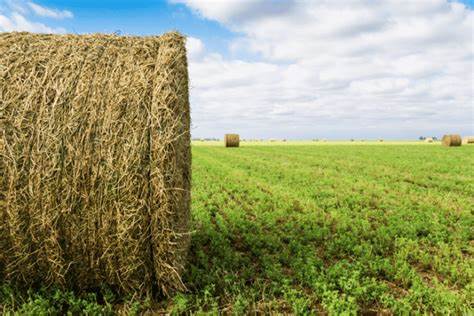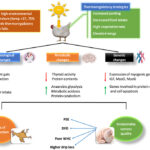
1. Introduction
Forage is the cornerstone of feeding systems for ruminants in most parts of the world, particularly in regions like South Asia and Sub-Saharan Africa. However, forage availability is not constant throughout the year. The periods when forage availability is critically low, affecting animal health and productivity, are termed lean periods or forage deficit periods. These lean periods vary with climate, cropping patterns, and land use but are generally associated with extremes in weather—either drought or cold, depending on the region.
2. Lean Periods in Forage Production
a. Causes of Lean Periods
- Seasonal climatic variations:
- Dry seasons in arid and semi-arid zones lead to reduced forage growth due to low rainfall.
- Cold winters in temperate or high-altitude regions limit forage growth because of frost and dormancy in many grass species.
- Overgrazing and land degradation:
- Continuous grazing without rest periods leads to the depletion of forage resources.
- Soil compaction and erosion reduce regrowth capacity.
- Poor pasture management:
- Lack of planned rotational grazing or pasture rest periods decreases biomass production.
- Land use changes:
- Conversion of grazing lands to crops or urban areas reduces available grazing land.
- Dependence on rainfed systems:
- In rainfed agriculture, forage supply closely follows rainfall patterns. Any delay or failure in rains leads to shortages.
b. Examples of Lean Periods by Region
- Pakistan & India (Tropical to semi-arid):
- Summer (May–June): High temperatures and limited forage due to dry conditions before monsoon.
- Winter (Dec–Jan): Limited green fodder due to low temperatures and frost.
- Sub-Saharan Africa:
- Late dry season (Feb–May): Grasslands dry up and quality of forage deteriorates.
- Temperate zones:
- Winter (Nov–Mar): Snow or frost covers pastures; plants go dormant.
3. Impacts of Forage Shortage during Lean Periods
- Reduced animal productivity: Decline in milk yield, weight gain, and reproduction.
- Increased mortality: In extreme shortages.
- High cost of feeding: Purchase of commercial feed or concentrates.
- Livelihood threats: Particularly in pastoral and smallholder farming systems.
4. Methods to Overcome Forage Shortages during Lean Periods
A. Conservation Techniques
- Silage Making:
- Preservation of green fodder (e.g., maize, sorghum, Napier grass) in anaerobic conditions.
- Ensures supply during dry or cold seasons.
- Hay Making:
- Drying and storing grasses or legumes (e.g., alfalfa, clover) during the surplus period.
- Useful for winter or dry season feeding.
- Urea Treatment of Straw:
- Enhances nutritional value of poor-quality crop residues (e.g., wheat or rice straw) by improving digestibility and crude protein content.
B. Forage Crop Planning and Diversification
- Use of multi-cut forage crops:
- Crops like Napier-Bajra hybrid, alfalfa, and Sudan grass can be harvested multiple times and stored.
- Staggered sowing:
- Different sowing times for the same crop to extend harvesting period and ensure continuity.
- Perennial forage crops:
- Perennial legumes and grasses provide year-round cover and biomass.
- Examples: Leucaena leucocephala, Brachiaria spp.
C. Improved Grazing Management
- Rotational Grazing:
- Alternating grazing areas to allow forage regrowth.
- Deferred Grazing:
- Allowing some areas to grow and set seed before grazing—especially for natural grasslands.
- Controlled stocking rates:
- Matching animal numbers to pasture capacity to avoid overgrazing.
D. Integration of Fodder Trees and Shrubs
- Trees like Leucaena, Gliricidia, and Sesbania serve as “fodder banks.”
- Provide high-protein leaves during dry seasons.
- Help maintain soil fertility and prevent erosion.
E. Use of Alternative Feed Resources
- Crop residues and agro-industrial by-products:
- Wheat bran, molasses, cottonseed cake, and sugarcane tops can partially substitute for green fodder.
- Hydroponic green fodder:
- Rapidly grown sprouts (e.g., maize, barley) without soil; available in 7–10 days.
- Useful for small-scale farmers with limited land.
F. Policy and Institutional Support
- Community fodder banks:
- Collective storing of hay or silage for community access during shortages.
- Weather-based advisory systems:
- Help farmers anticipate forage shortages and plan accordingly.
- Subsidies and support for forage cultivation:
- Encouragement for farmers to grow dedicated fodder crops through seed subsidies, technical training, and irrigation support.
5. Conclusion
Lean periods in forage production are a significant constraint in livestock-based systems, particularly in tropical, subtropical, and arid regions. Addressing these periods requires a multi-pronged approach combining conservation, smart crop planning, use of alternative feed resources, and improved grazing management. Investment in farmer training, infrastructure for fodder conservation, and government support programs are also crucial to ensure year-round feed availability, improve livestock productivity, and sustain rural livelihoods.




This topic division is outstanding
23-CUVAS-0337
DVM (4th semester)
Muhammad Saqib
Reg no:23-cuvas-0300
DVM 4th semester
Good explanation of lean period
23 CUVAS 0311
Muhammad AQIB
Laiba Hafeez
Reg no : 23-cuvas-0298
Muhammad Ahmad. DVM 4th 23 -cuvas-0316
Muhammad Saqib
DVM 4th semester
Reg no:23-cuvas-0300
Reg no 23-cuvas-0308
This is very informative and helpful information.
This is very informative and helpful information of lean period
Muhammad Ahmad. DVM 4th 23 -cuvas-0316
23-CUVAS-0320
DVM(4th semester)
23-CUVAS-0306
Laiba Hafeez
Reg no :23-cuvas-0298
Dvm 4th semester
23-cuvas-0320
DVM 4th semester
Reg . No.23-cuvas-0308
23-CUVAS-0337
DVM (4th semester)
23-CUVAS-0320
DVM(4th semester)
23-cuvas-0314
23-cuvas-0320
DVM 4th semester
Waseem saleem
23-cuvas-0326
DVM 4th
Waseem saleem
23-cuvas-0326
Outclassed material
Muhammad Ahmad. DVM 4th 23 -cuvas-0316
Muhammad Saqib
Reg no:23-cuvas-0300
DVM 4th semester
Hafiz Muhammad Ishaq
Reg #: 23- CUVAS -321
DVM 4th semester
Useful information
Bhut khoob
Muhammad Saqib
DVM 4th semester
Reg no:23-cuvas-0300
23-cuvas-0330
Dvm 4 semester
23-cuvas-0330
Preetam Raam
23-CUVAS-0334
DVM 4th
23-CUVAS-0320
DVM(4th semester)
Reg#:23-CUVAS-0312
DVM 4TH
23-cuvas-0322
23-cuvas-0300
23-cuvas-0320
DVM 4th semester
23-cuvas-0321
M. Ibrahim
23-cuvas-0299
The content of nutrition is very informative!.This is very lineant and accessible way of study.
Muneer Ahmad
23-cuvas-0323
DVM 4th
23-cuvas-0321
23-Cuvas-0332
23-Cuvas-0332 Awesome
Informative site
325
23-CUVAS-0315
M. Farqleet Khan